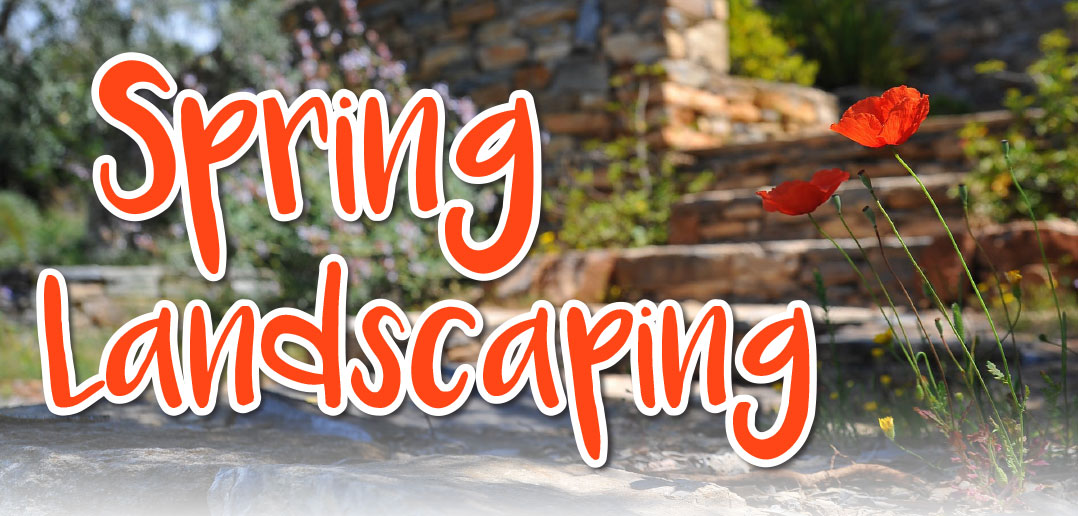Spring Landscaping
As yards finally turn green and trees begin to bloom, most of us are ready to get our lawns in order. There’s no better time to start on all the lawn care, landscaping, and decorative projects to make your yard look its best. To get the most use and enjoyment out of your lawn, you will need to set some goals and take actions to accomplish them.
Lawn
It’s important to establish a healthy lawn as the base of your landscape. After all, no matter how much money you invest in retaining walls, perennials, trees, etc. your lawn won’t be at its best without a green, lush grounding. Lawns should be kept between 2 3/4 and 3 3/4 inches in order to ensure root quality and reduce weeds. It’s easy to let lawns get out of hand, so your lawn should be mowed every two weeks.
AKRS Equipment has all the lawn equipment that you could need to keep your lawn from becoming a jungle this spring. Nick Wessel, a turf and commercial equipment sales professional at AKRS Equipment, gave us a quick debrief on what his company is all about.
“AKRS Equipment is a full service dealer with parts, service, and sales on John Deere and Stihl equipment,” he said. “We offer a Ready-to-Mow service where we come to you to service your equipment. That way, your machines are ready to go when you are. It’s always suggested to service your equipment before the spring season begins to ensure that your lawn doesn’t get out of hand.”
If you are unfamiliar with how to service your lawn mower or other John Deere or Stihl equipment, you should refer to a professional to make sure you don’t accidentally damage your own equipment.
Nick told us about a common mowing mistake: “Many people sharpen their mower blades to be extremely sharp, but they should actually be maintained to the original bevel edge,” he said. “If they are razor sharp, the sharp edge will roll over and dull quickly. It’s recommended to keep your blades at a .40 millimeter (1/84 inch) cutting edge or less.”
Nick told us about common signs that you should see a professional about your equipment. These include:
- Poor cut quality
- Leaving a trail of cut or uncut grass
- Grass clumping
- Poor bagging performance
- Uneven cut
Beyond lawn equipment maintenance, if there are areas of your grass that have turned yellow and died, then you should consider overseeding. Overseeding should be done after aeration, when the soil is open and ready to germinate seeds. Spring overseeding is best done between April 1 and 30 for Kentucky bluegrass and between April 15 and June 15 for tall fescue. Overseeding will allow fresh grass to grow and re-establish a strong root system. Make sure that your sprinkler system is up and running so that you can properly germinate your new grass.
A large project that irrigation specialists and DIY extraordinaires take on every season is preparing irrigation systems after being in a winterized state. Getting your system correctly ready for sping and summer will save water and money. Your grass needs time to wake up from a dormant state, so the water should enter the system gradually. Following these steps can ensure a smooth process:
- Prior to pressurizing the system, check your backflow device for damage
- Never open the water too quickly to avoid damaging your mainline or valves
- Inspect each zone and fixed nozzle for possible wear and tear, obstructions, and other damage
- Check to see where each nozzle is spraying, and make sure not to waste money by spraying sidewalks or driveways
- Program the controller so that the water flow rate does not exceed the soil’s absorption capability
Activating your lawn in the spring can be frustrating, time-consuming, and possibly risky to navigate through all the technicalities of your sprinkler system. It can also lead to expensive breaks and repairs. Not only that, if done incorrectly, it can lead to your system breaking down mid-summer and destroying the health of your grass.
Many people already have trusted professionals that they work with while others are in the market for lawn assistance. No matter your circumstance, make sure you speak with lawn care professionals ahead of time on how you want your lawn to be serviced. Be sure to cover all the bases by speaking up about your preferences and concerns in an upfront manner. You want to make sure that nothing is assumed and you are all on the same page.
Planting
While you may think you need exotic plants to make your yard look unique, there are actually a large variety of Nebraska-native plants that are just as beautiful as non-native plants. Using native plants ensures that your garden will thrive even through Nebraska’s crazy weather. They also require less watering on average and no chemical fertilizers and pesticides because they’re adapted to the environment, unlike their foreign competitors. Natives also make better environments and food sources for pollinators, especially those that migrate! Exotic plants can sever the food web of your ecosystem and even become an invasive pest.
To emphasize how important it is to plant local, research by the entomologist Dough Tallamy found that native oak trees support over 500 species of caterpillars, whereas ginkgos, a common alternative native to Asia, host only five species. If you want beautiful butterflies and moths to visit your lawn, it’s important that you provide plants that they can interact with.
- Here’s a list of native-Nebraska plants that could liven up your garden:
- Purple Poppy Mallow
- Blackeyed Susans
- Coneflower
- Beardtongue
- When planning your garden, it’s important to consider if the plant could potentially attract pollinators.
Increasing the number of pollinators that visit your garden is definitely a win-win for you. Not only do you get to say you did your part to help the environment, you also get beautiful plants that are more resilient and healthy. An easy pollinator to attract is birds. The bird population booms in the summer as they come back from migrating, so they can put a lot of stress on their natural food resources. Setting up bird feeders in your yard is an easy way to have a positive impact on your local ecosystem. While an obvious benefit is being able to bird watch, you also help to create healthier birds that can go on to feed their chicks.
Here are additional steps you can take to attract pollinators to your yard:
- Provide local, native food sources for insects
- Provide clean water
- Leave some nesting sites like soft dirt, hollow branches, and holes in wood
- Reduce or eliminate insecticide and herbicide use
While some people shy away from ‘messy’ plants that shed fruits and nuts, these are actually the most likely to attract pollinators to your yard! Those pollinators will be a natural improvement to your environment for months after the spring fades since most flowering plants require pollinators. As an added bonus, they’re a great way to teach your children to appreciate nature and understand ecosystems!
Another aspect of landscape planning you have to keep in mind is the plant’s mature size, intent, and function, which relates to the level of maintenance it will require. Shrubs and trees should be planted cautiously. Most trees will require trimming every growing season to avoid fall growth spurts and desiccation burn, while most perennials will not require deadheading (removal of dead flowers) to re-bloom. Make sure you consider the level of maintenance you’re willing to complete when deciding what to plant.
If you do decide to plant a tree or anything else, Honeyman Rent-All has all the equipment you could possibly need. Since most trees only need to be cleaned up once a year, it may be more economically efficient to simply rent an electric trimmer than buying one. The same can be said for a lot of lawn equipment, since many of us don’t have the money or garage space to buy every garden tool for a once-a-year activity. If that’s the case, consider renting. Honeyman has all the equipment required to start a large yard project. They have riding aerators, augers, leaf blowers, chippers, trimmers, and more to satisfy all your landscaping needs.
The best time to plant trees is during their dormant period, typically early spring or late fall. Trees really are lifelong investments for your property, so it’s important to give them all the resources they require to grow. There are many factors that affect sapling health—how well suited it is to the planting location, proper planting, follow-up care, soil type, etc. Getting your tree to mature to its full size will provide you with environmental and economic benefits throughout its lifetime.
Determining where to plant a tree is not a decision to be taken lightly, and it is definitely recommended to consult a landscaping professional before starting the long process. Tree growth must not interfere with underground or overhead lines. If you accidentally plant a tree too close to your house, you’ll be kicking yourself in the future when falling branches cause property damage or roots interfere with pavement.
According to research conducted by the USDA Forest Service, energy savings, storm-water runoff reduction, cleaner air, and higher property values lead to trees producing three times more of an economic advantage than their cost. Each large front yard tree adds approximately 1% to the house sales price. Additionally, strategically placed trees can also help house owners save up to 56% on annual air-conditioning costs. The Forest Service Center found that the annual net benefit per tree is $60. So, not only do they look great, they’re great for your pocket too!
With the arrival of spring, take some time to escape outside and make the world a little better by keeping your yard healthy and beautiful.


